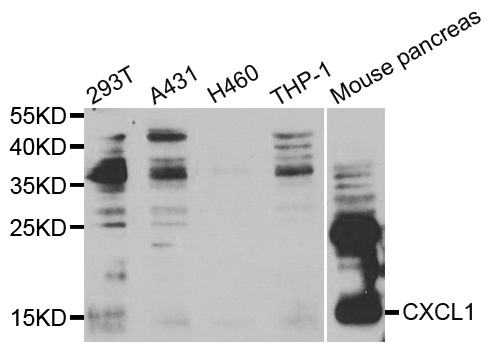CXCL1 Polyclonal Antibody
RD219462A
ApplicationsELISA, ImmunoHistoChemistry
Product group Antibodies
ReactivityHuman, Mouse, Rat
TargetCXCL1
Overview
- SupplierReddot Biotech
- Product NameCXCL1 Polyclonal Antibody
- Delivery Days Customer5
- ApplicationsELISA, ImmunoHistoChemistry
- CertificationResearch Use Only
- ClonalityPolyclonal
- Concentration1.02 mg/ml
- ConjugateUnconjugated
- Gene ID2919
- Target nameCXCL1
- Target descriptionC-X-C motif chemokine ligand 1
- Target synonymsFSP, GRO1, GROa, MGSA, MGSA-a, NAP-3, SCYB1, growth-regulated alpha protein, C-X-C motif chemokine 1, GRO-alpha(1-73), GRO1 oncogene (melanoma growth stimulating activity, alpha), GRO1 oncogene (melanoma growth-stimulating activity), MGSA alpha, chemokine (C-X-C motif) ligand 1 (melanoma growth stimulating activity, alpha), fibroblast secretory protein, melanoma growth stimulating activity, alpha, melanoma growth stimulatory activity alpha, neutrophil-activating protein 3
- HostRabbit
- IsotypeIgG
- Scientific DescriptionCXCL1 (C-X-C Motif Chemokine Ligand 1) is a Protein Coding gene. Diseases associated with CXCL1 include Melanoma and Bacterial Meningitis. Among its related pathways are Peptide ligand-binding receptors and Chemokine Superfamily Pathway: Human/Mouse Ligand-Receptor Interactions. GO annotations related to this gene include receptor binding and chemokine activity. An important paralog of this gene is CXCL2.This antimicrobial gene encodes a member of the CXC subfamily of chemokines. The encoded protein is a secreted growth factor that signals through the G-protein coupled receptor, CXC receptor 2. This protein plays a role in inflammation and as a chemoattractant for neutrophils. Aberrant expression of this protein is associated with the growth and progression of certain tumors. A naturally occurring processed form of this protein has increased chemotactic activity. Alternate splicing results in coding and non-coding variants of this gene. A pseudogene of this gene is found on chromosome 4.
- ReactivityHuman, Mouse, Rat
- Storage Instruction-20°C
- UNSPSC12352203




